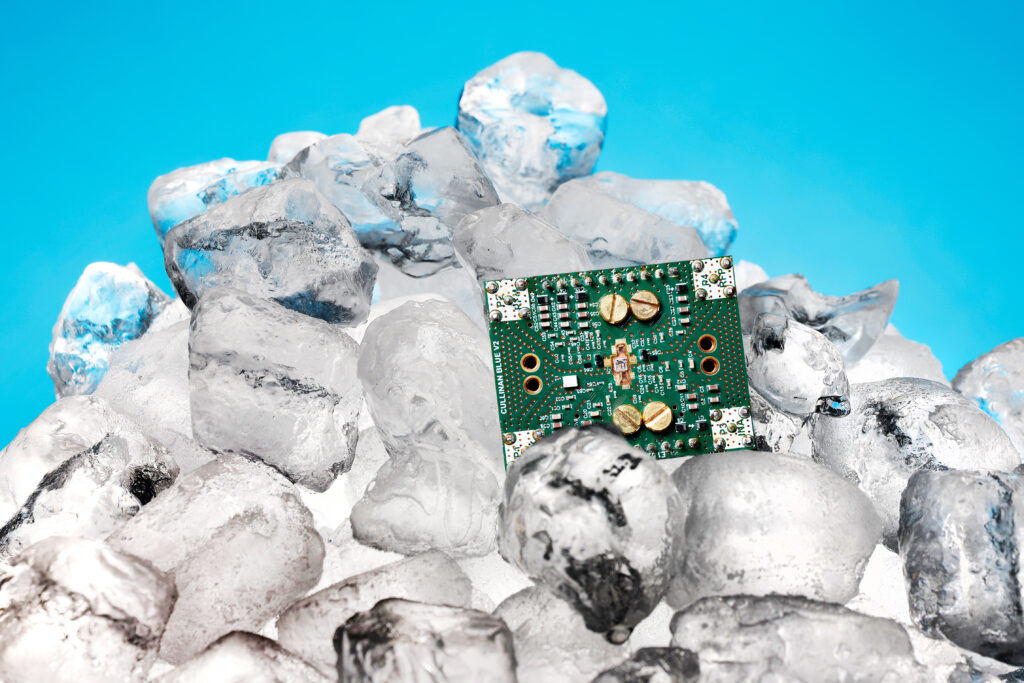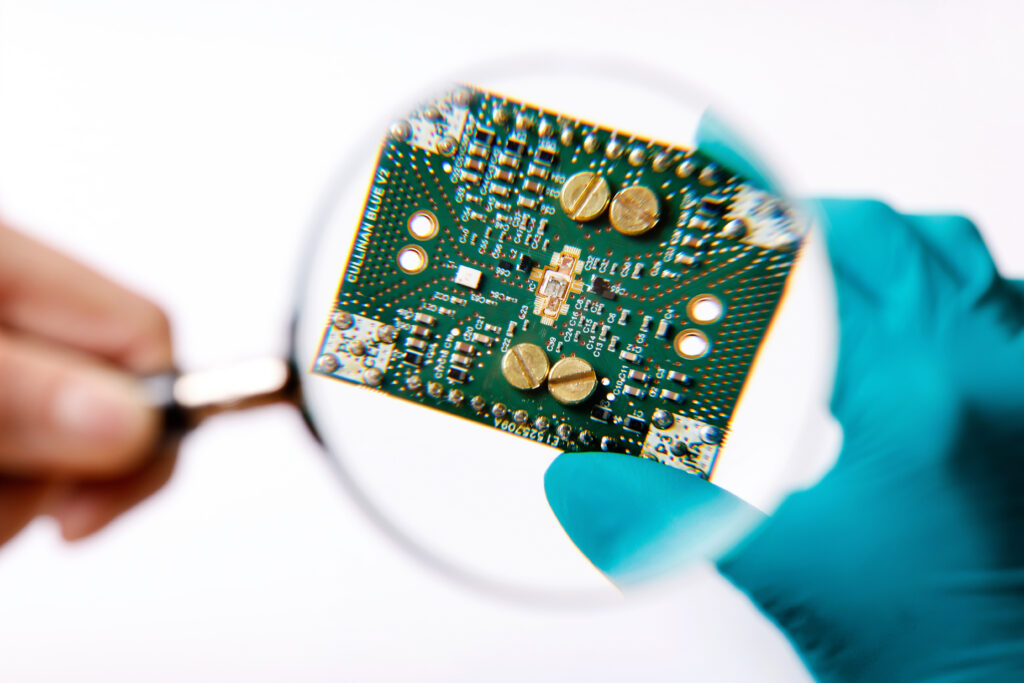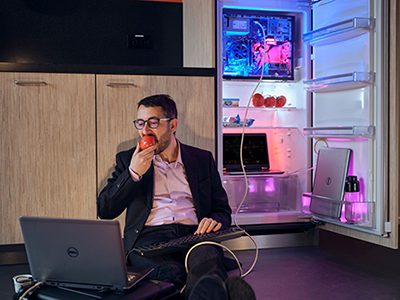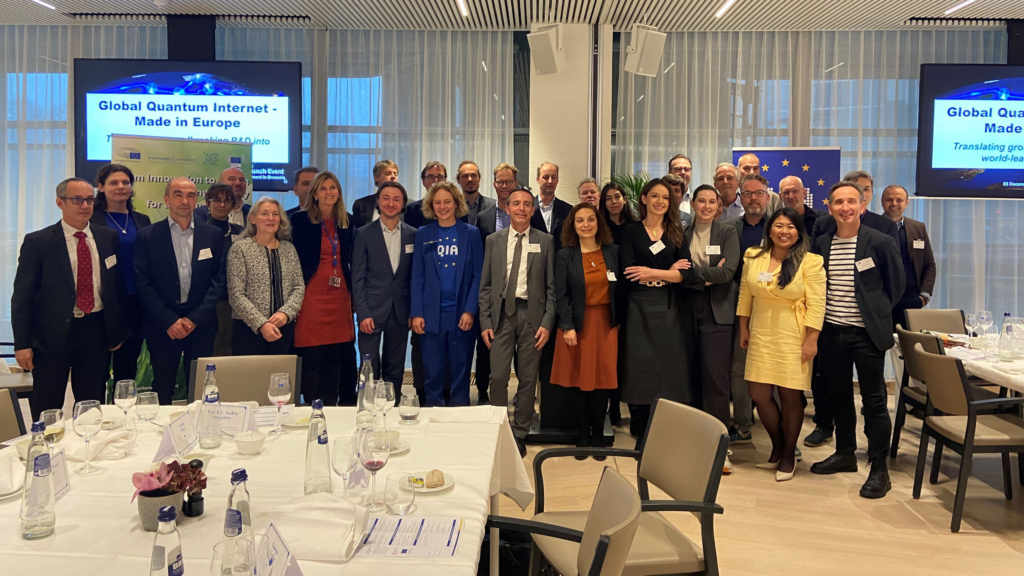20.02.2024Quantum Computing
Freezing electronics to control diamond spin qubits

Researchers from Fujitsu and QuTech have developed new and ultra-cold electronic circuits to control diamond-based quantum bits. As a result of their joint research project, it becomes possible to build larger quantum computers, through overcoming the ‘wiring bottleneck’, while maintaining high quality performance. In fact, both the quantum bits and the control electronics can be conveniently operated in a single compact cryogenic refrigerator. The researchers publish their results at IEEE’s ISSCC.
The functional quantum computer of the future will contain millions of quantum bits, or ‘qubits’. They will be able to process complex problems much faster than classical computers, especially in fields like cryptography, optimization, and simulation. Moreover, they will be able to solve problems that are impossible for classical computers, marking a significant milestone in computational history.
Close to absolute zero
Before that, a few challenges need to be overcome. One of these is maintaining the extremely low temperature at which the qubit typically operates. Qubits make use of extremely fragile quantum effects that are perturbed by many things, like even the smallest amount of heat. Therefore, qubits are cooled down to the coldest temperatures possible, close to absolute zero: 0 kelvin (or -273°C).
It is already quite a feat to cool anything down to such temperatures: it would be a shame if heat leaked into the heart of a quantum computer while making calculations. That heat would immediately destroy the information that a qubit was holding, rendering any quantum computer unreliable and unusable. It is now conventional to keep a few qubits cold enough by placing them in a small cryogenic refrigerator and connecting them with a few wires to the electronics outside the fridge. However, it is very hard to cool down thousands or even millions of qubits addressed with as many wires coming out of the refrigerator. That many wires between the cold qubits and the room-temperature electronics dramatically impacts reliability, manufacturing and the size of the device.

Freeze the electronics!
Why not freeze the whole computer, instead of just the qubits? That’s easier said than done, since most integrated circuits are built to withstand only ambient temperatures from -40°C to +125°C, temperatures much higher than the typical qubit’s temperature. But this is exactly what researchers and engineers at QuTech—a collaboration between the TU Delft and TNO—did. They used cryo-CMOS hardware to withstand the extreme temperatures of a qubit fridge, without sacrificing the performance of the whole system and its scalability.
Lead investigator Fabio Sebastiano (QuTech and TU Delft) explains: “In designing electrical systems, there is always a balance between performance and power: the increase of one means a decrease of the other. Our challenge is obtaining high performance, while also not limiting the power consumption. This is crucial as too much power could overheat the cryogenic refrigerator used to keep the system at a low temperature. We used specific cryogenic electronic controllers (cryo-CMOS controllers) to alleviate the interconnect bottleneck: now we need fewer wires to enter the cryogenic fridge, which greatly enhances the scalability of the whole quantum computer.”
His colleague (also QuTech and TU Delft) and principal investigator Masoud Babaie adds: “To further refine cryo-CMOS controllers, a combined design approach of electronics and quantum processors is beneficial. This involves strategically arranging and connecting qubits to the controllers. Addressing any quantum platform requires a careful examination of signal needs and controller optimization for scalability, focusing on reducing power usage and physical size. This is essential for the development of larger quantum computers.”
Dr. Shintaro Sato, Fellow, SVP & Head of Quantum Laboratory at Fujitsu Research, Fujitsu Limited, explains: “Wiring between control circuits and qubits is a common problem in the process of scaling up quantum computers. Results of our joint research highlight the potential of cryo-CMOS technology for diamond spin qubits to overcome this bottleneck. We anticipate that the new technology will enable us to achieve the high scalability expected in quantum computers using diamond spin qubits.”
(Text continues below)
Stories of Quantum
Dreaming of the quantum computer
Doing incredibly fast calculations to develop even better new medicines. That is just one of the things that will be possible in the future thanks to a quantum computer. It’s the dream of Fabio Sebastiano from QuTech and the Faculty of Electrical Engineering, Mathematics & Computer Science (EEMCS). He is devising solutions to make this device a reality.

From spin qubits to diamonds
Previously the researchers achieved a cryogenic controller for spin qubits in silicon. While those spin qubits can (in principle) be manufactured in a standard integrated-circuit process (e.g. CMOS) together with the cryogenic electronics, the diamond qubits used here have several other advantages. They have better fidelity, they can be more easily remotely connected with each other, thus making space for nearby electronics, and they can operate at (relatively) higher temperature. The higher operating temperature is particularly relevant for the electronics, as operating at 1 kelvin (-272.15°C) is difficult but simpler than operating at 0.020 kelvin.
Next steps
The work signifies a big step by showcasing cryogenic electronics for diamond qubits for the first time. While the very significant first step of controlling a single-qubit with cryogenic electronics has been now achieved, the researchers are already working on the next steps by adding all the other required functionalities, such as expanding from 1-qubit operation to 2-qubit operations and implementing the qubit read-out functionality, and by generally scaling up to a larger quantum processors.
Publication details
“A Cryo-CMOS Controller with Class-DE Driver and DC Magnetic-Field Tuning for Color-Center-Based Quantum Computers”, L. Enthoven, N. Fakkel, H. Bartling, M. van Riggelen, K-N. Schymik, J. Yun, E. Tsapanou Katranara, R. Vollmer, T. Taminiau, F. Sebastiano, M. Babaie, 2024, IEEE International Solid-State Circuits Conference (ISSCC).



